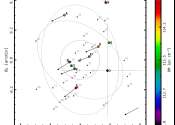New tidal stellar stream discovered with Gaia
By analyzing the data from ESA's Gaia satellite, Chinese astronomers have detected a new tidal stellar stream in the northern hemisphere, which has a low metallicity and a relatively high energy. The finding was reported ...









